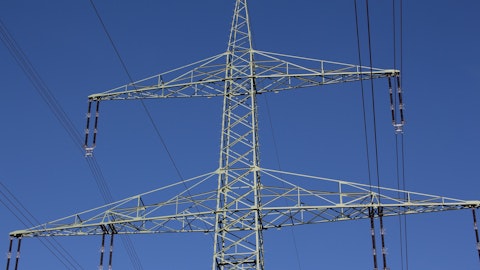Operator: The next question comes from Sebastian Kuenne from RBC Capital.
Sebastian Kuenne: My question relates to the IT division. I was wondering if you could give us a bit more color on the exposure that you have in automotive. And what activity you see, especially from the electric car and battery assembly. If there’s a slowdown or if you should be aware that the tender activity is slowing because there was a big wave of electric car assembly lines being built and now, we have to fill those capacities before we go into the next stage. Maybe you can give us a bit more color there?
Mats Rahmstrom : And more than Industrial Techniques business, more than 50% of the business is related to the auto sector, that’s car manufacturing, truck manufacturers and Tier 1s seat manufacturer, for example. Over the last few years, the big CapEx spend has been in electric vehicles. We have seen that the Chinese has been most active, also Tesla, of course, from Americas. And now we see that a lot of the battery makers are, of course, the full value chain you see in China, but we also see that more and more of the European open up their own battery factories to do at least assembly and the packaging. So we have seen more activity than in Europe in this quarter, I would say, catching up maybe technology wise. And I think also that we will see that in Americas.
And of course, that there’s so many Chinese EV manufacturers. So at least myself would expect the consolidation. But I think it was in this quarter that BYD became a bigger player than Tesla. And I think the main problem right now is that only 13%, 15% of the car solar is EV and it’s up plus consumer then to drive the market a little bit. And I think it’s a little bit on hold, as you said. And I think everyone is re-evaluating the investment, how it should look like and how the portfolio should, but I don’t think it will stop, and I don’t think personally that it will stop, I think it’s a transformation that is needed for the environment. So we are ready and we have equipment for traditional technologies, the combustion engine or EVs. And we think that for us, it’s beneficial that the market transforming to EVs, where we have a number of applications on the batteries which is the new drivetrain, so to say, and also on the body.
So for us, stronger Europe, higher expectation on Americas and a little bit softer than China, as we have seen it in this quarter.
Operator: The next question comes from James Moore from Redburn Atlantic.
James Moore: Mats, Peter, can you hear me?
Mats Rahmstrom : We can hear you?
James Moore: Just a question on compressor and the order environment, if I could. I mean, you’ve just done SEK 17 billion, and we’ve had three quarters of over SEK 20 billion, averaging SEK 21 billion. I guess do you see this as a more normal quarter after three quarters of exceptional or the other way around? And I’m trying to think about the energy transition, the move towards hydrogen, carbon capture, where there is a secular story out there, which would drive orders upwardly over time versus the cyclical aspect of the macro and really how you see those two things playing out and where you think we are in that and whether the mix of the business is changing?
Mats Rahmstrom Atlas : I can start. I know that a few quarters ago, Daniel tried to investigate a little bit for the group at least. And of course, part of — a big part of the group for the sustainable application, as you say, linked to CT. And then it was around 10%, 12%, that was this new type of technologies that we were linked to. We don’t have an updated measure. It’s not a normal measure for us. But for sure, when I listen to what happens in gas and process, what happens in oil-free, some of the segments. I mean, the battery manufacturer, for example, have been a huge impact, a positive impact for us in China when it comes to the oil-free machines. So it is shifting and a little bit. That’s why I made a point in the beginning as well that independently of what gas will win if it’s hydrogen or liquid natural gas, any gas that needs to be compressed, moved somewhere and used then, of course, we will have products for these segments.
I’m not so sure I give you a good answer, but that’s a little bit — well, we see it. I don’t know if you could add something on the normal. I don’t know if there is a normal…
Peter Kinnart: I wouldn’t call this quarter being more normal than other quarters. What is true is that gas process has been a bit softer year-on-year. But that again has more to do with the nature of the business. The big-ticket items that are part of the portfolio and the different types of applications that we are offering to much more than we used to a couple of years ago. And as just like Q1 2023 was a big surprise, you could say, in terms of the amount of orders that dropped at more or less at the same day. You could also say that we just happen to have fewer orders out of the quotation portfolio that we have out there in Q4. But I wouldn’t say that this is automatically a normalized quarter compared to others. I think we have also indicated previously that we have seen a bit of a trend on the industrial compressor side, that the large demand for the large units or the orders for the large units continue on a steadier pace, while for the small medium enterprises, the appetite to decide in security with small, medium enterprise owners is a bit higher.
And given then also the shorter lead times. And of course, also when we talk about distribution, having some higher stock levels, for example, we see a bit of a softer development on the small, medium size currently, while the large units continue based on the fact that decisions have already been taken in the boardrooms, do we make these investments. There’s longer discussions about technical specs and about the installations. And ultimately, of course, the delivery times also are, by definition, larger for the larger equipment. And I think that is what leads them to the current development, both on the industrial compressor side as well on the gas and process side.
Operator: The next question comes from Jonathan Day from HSBC. Jonathan Day?
Jonathan Day: I was wondering if you could talk a little bit more about what you’re seeing in China. I know you’ve touched a little bit about it in sort of VT and IT, but just in the sort of other divisions as well in terms of the sort of trajectory that you’re seeing there when you saw any more sort of kind of a turnaround activity levels, that would be really useful.
Mats Rahmstrom : Of course, you see — you already had an update on CT, but that was the industrial compressors grew a little bit. We could, of course, vacuum that stood out.
Peter Kinnart: Vacuum Technique was, I would say, overall, a bit negative, mostly from semi, but also due to the fact that we saw this development now gradually, which we, I think, also commented on earlier that also in the scientific base as well as in the industrial vacuum, we have also seen a stronger decline in the order development than we have seen in previous quarters, and that has been particularly also the case in China. For CT, we indicate that industrial compressors are still up but we see a bit of a softer market overall. But again, here, the same comment with regard to small, medium enterprises versus the larger types of equipment. GAAP was also a little bit weaker in Asia overall, but we still believe that the GAAP orders are strong, but just slightly lower for the moment.
Mats Rahmstrom : Industrial Technique, as I mentioned a couple of times, I mean this has been the booming market for EVs. And at the time, we see that it’s being more flat and more difficult to take decisions. And of course, you can always expect that there might be some more capacity in the industry. And in Power Technique, it’s not their strength in China, but they do well with the portable bigger machines as well. What’s outstanding and what they do really well is on the industrial pumps. I cannot judge the market. I can just see that we do really well, and I know that PT has more than double-digit growth in Asia at this point.
Peter Kinnart: Okay. Thank you, Mats, for answering that final question. We are at the end of the hour for this earnings call. I would like to thank all the participants for taking part in this call and to provide us with your questions. Should there be any more questions, our IR department will be more than happy to help you and try to guide you on whatever question you might have. With that, I would like to close the call for today, and thank you all for participating. Thank you.
Mats Rahmstrom: Thank you so much
Follow Atlas Copco Ab-Spons Adr A (OTC:ATLKY)
Follow Atlas Copco Ab-Spons Adr A (OTC:ATLKY)
Receive real-time insider trading and news alerts





